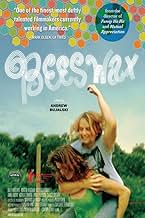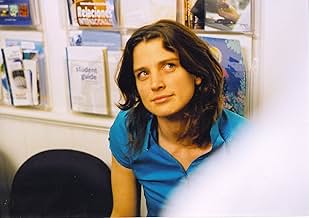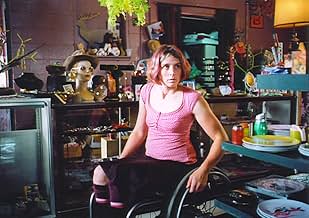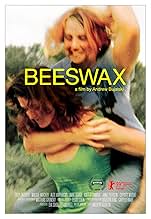A pair of identical twin sisters -- one, who has been paraplegic since youth and gets around in a wheelchair, and the other -- 'same face, different bodies.'A pair of identical twin sisters -- one, who has been paraplegic since youth and gets around in a wheelchair, and the other -- 'same face, different bodies.'A pair of identical twin sisters -- one, who has been paraplegic since youth and gets around in a wheelchair, and the other -- 'same face, different bodies.'
- Awards
- 1 nomination total
- Director
- Writer
- All cast & crew
- Production, box office & more at IMDbPro
Featured review
Jeannie (Tilly Hatcher), a girl in a wheelchair, owns a vintage clothing store. Amanda, her business partner, is deeply unsatisfied with how she runs the business and is considering a legal battle for ownership. Merrill (Alex Karpovsky), a young law student tries to help Jeannie by offering emotional support and legal advice, as well as introducing her to potential buyers. In the meanwhile, Lauren (Maggie Hatcher), Jeannie's slacker twin sister, looks for steady work and a general direction in her aimless drifter lifestyle. Finally, a new clerk is a welcome addition to the store but things get complicated when she turns out to be a tad too sentimental.
Heralded as the King of the Mumblecore movement, Bujalski's films are uneventful "slices of life" naturalistic depictions of youth in shambles. Each story is a tragic tale of emotional teetering on the edge of madness. For this he has been compared to Cassavetes, but Bujalski's life depictions are actually sexless, unrooted, and deceptively intellectual (but not in a negative way).
His characters recede inside themselves as they attempt to grasp for an adequate language to express what might be a conditionally repressed intensity. In a sense, they are the opposite of Cassavetes' bombastic, larger than life, overexpressive characters. But his means of examination are the same: full shots of bodies, matter-of-fact depictions of communicative behavior (mannerisms, tics), faces chosen for their anti-cinematic potential, so plain that they make our expected systems of dramatic representation collapse. Along the way we discover new modes of being, and an almost ethnographic look at human presence.
Above it all, there is a kind of hidden essay on filmmaking and creativity:
The sisters are twins. ('Same face, different bodies')
The clothing store is called Storyville.
Jeannie, paralyzed from the waist down as an audience surrogate, the "sitting down" metaphor, the watcher/observer, and the "real" manager of Storyville. She's involved in a legal dispute over the ownership of the store. The differences with the other owner are creative ones.
Merrill, a law student, interested romantically in Jeannie, but also an artist, a kind of surrealist writer, always commenting on situations with non sequiturs, exaggerations, cartoonish excesses.
Lauren, the second twin, her introductory scene sees her breaking up with a "boyfriend". She appears confused, or fickle. But she's obviously a lesbian. Throughout the movie she looks for work, speculates on possible futures, hangs out with drug addicts. The closest thing to a 'drifter' character in the story. She's the quantum fulcrum. It is through her presence that everyone else can feel anchored.
Bujalski is popularly misunderstood. His desire to shoot 16mm, "small" stories and his use of first-time actors, tie him to a deeply experimental and innovative tradition of art cinema (Cassavetes, Jem Cohen, Andy Warhol, Pedro Costa). One can only hope he keeps on working without being too affected by the lack of popular approval. In my mind, he is constantly refreshing, layered, and dangerous, if you see cinema as a kind of schizophrenic simulation machine.
Heralded as the King of the Mumblecore movement, Bujalski's films are uneventful "slices of life" naturalistic depictions of youth in shambles. Each story is a tragic tale of emotional teetering on the edge of madness. For this he has been compared to Cassavetes, but Bujalski's life depictions are actually sexless, unrooted, and deceptively intellectual (but not in a negative way).
His characters recede inside themselves as they attempt to grasp for an adequate language to express what might be a conditionally repressed intensity. In a sense, they are the opposite of Cassavetes' bombastic, larger than life, overexpressive characters. But his means of examination are the same: full shots of bodies, matter-of-fact depictions of communicative behavior (mannerisms, tics), faces chosen for their anti-cinematic potential, so plain that they make our expected systems of dramatic representation collapse. Along the way we discover new modes of being, and an almost ethnographic look at human presence.
Above it all, there is a kind of hidden essay on filmmaking and creativity:
The sisters are twins. ('Same face, different bodies')
The clothing store is called Storyville.
Jeannie, paralyzed from the waist down as an audience surrogate, the "sitting down" metaphor, the watcher/observer, and the "real" manager of Storyville. She's involved in a legal dispute over the ownership of the store. The differences with the other owner are creative ones.
Merrill, a law student, interested romantically in Jeannie, but also an artist, a kind of surrealist writer, always commenting on situations with non sequiturs, exaggerations, cartoonish excesses.
Lauren, the second twin, her introductory scene sees her breaking up with a "boyfriend". She appears confused, or fickle. But she's obviously a lesbian. Throughout the movie she looks for work, speculates on possible futures, hangs out with drug addicts. The closest thing to a 'drifter' character in the story. She's the quantum fulcrum. It is through her presence that everyone else can feel anchored.
Bujalski is popularly misunderstood. His desire to shoot 16mm, "small" stories and his use of first-time actors, tie him to a deeply experimental and innovative tradition of art cinema (Cassavetes, Jem Cohen, Andy Warhol, Pedro Costa). One can only hope he keeps on working without being too affected by the lack of popular approval. In my mind, he is constantly refreshing, layered, and dangerous, if you see cinema as a kind of schizophrenic simulation machine.
- foldedspacemonkey
- Jan 21, 2013
- Permalink
Storyline
Did you know
- TriviaThe two leads, Maggie and Tilly Hatcher, are real life long time friends of Director Andrew Bujalski. His script was inspired by his feeling of how the sisters would project as performers (as they are not professional actors).
- SoundtracksStarlight
Written and Performed by Escort
Published by Sweet Sensation Publishing (ASCAP)
Courtesy of Escort Records
Details
Box office
- Gross US & Canada
- $46,590
- Opening weekend US & Canada
- $5,844
- Aug 9, 2009
- Gross worldwide
- $46,590
Contribute to this page
Suggest an edit or add missing content















